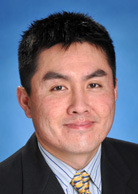About 50 to 60 percent of patients with melanoma have a mutation in the BRAF gene that drives the growth of their cancer. In clinical trials, most of these patients have responded remarkably well to two novel agents that inhibit the gene, but unfortunately, the response is almost always limited in duration, as the cancer develops a resistance to the drugs.
In a study published Aug. 1 as a Priority Report in the peer-reviewed journal Cancer Research, scientists at UCLA’s Jonsson Comprehensive Cancer Center tested a combination of small molecules that, when used with the BRAF inhibitors, may help overcome the drug resistance and extend the lives of those with advanced melanoma.
The team, led by researcher Dr. Roger Lo, focused on testing only small molecules already being studied in various phases of clinical trials in the hope of developing a combination treatment that can be studied in patients much more quickly than compounds that aren’t yet being tested in humans.
“These molecules we tested are already being studied in patients with other cancers, and some of them have very good toxicity profiles with few side effects,” said Lo, a Jonsson Cancer Center researcher and an assistant professor of dermatology and molecular and medical pharmacology at UCLA. “The idea was to combine some of these with the BRAF inhibitors and come up with something that we don’t have to wait years and years to use in patients. We need to find a way to combine these molecules so the cancer cell cannot get around them.”
This study builds on the discoveries from a previous study published by Lo last year in the journal Nature, which found that subsets of melanoma patients with BRAF mutations become resistant to BRAF inhibitors through either a genetic mutation in a gene called NRAS or through the overexpression of a cell surface–receptor protein.
That study debunked the theory that BRAF was finding a way around the experimental BRAF inhibitors by developing its own secondary mutation. The finding was important because it meant that second-generation drugs targeting BRAF would not work and should not be developed, saving precious time and money.
Lo and his team spent two years studying tissue taken from patients who became resistant to try to determine the mechanisms that helped the cancer evade the inhibitors. In the lab, they also developed drug-resistant cell lines, in collaboration with another UCLA lab headed by Dr. Antoni Ribas, also a Jonsson Cancer Center researcher. There are still other mechanisms of resistance in melanoma patients with mutated BRAF who are treated with BRAF inhibitors, the researchers say, and uncovering these additional mechanisms may provide even more targets for drug therapy.
Cancer operates like a criminal seeking to evade his captors, and the small-molecule inhibitors act as police barricades that seek to block the criminal’s escape. When one of the cell signaling pathways driving resistance is blocked, the cancer finds a way to activate another pathway that will drive its growth. If that pathway is blocked, yet another pathway may be activated. The goal is to find a way to block all the pathways helping the cancer evade therapy at once so the cancer cells die before finding a way around the drugs.
In the lab, Lo and his team applied one drug at a time to the resistant cancer cells to see what route or pathway the cancer used to escape. They would then find an inhibitor for that pathway. In the end, the researchers identified the most optimal combination of molecules to block the pathways PI3K, mTORC and MEK.
“Normal cells have physiologic safety mechanisms to avert death, and this is taken to a higher level by the cancer cell to serve its growth agenda, making single-agent targeted therapy insufficient,” Lo said. “We have to block several roads, which is what is behind our approach to developing combination therapies. The key was to figure out how to combine the molecules so that the cancer cannot get around them. Why wait for the cancer to escape? Let’s block all the pathways right from the start.”
Lo said this study highlights the need not only to identify mechanisms of acquired resistance to targeted inhibitors but also to understand the signaling network associated with each mechanism to generalize potential translatable approaches to overcome drug resistance.
Once the right combinations of drugs were used together, the inhibitors “consistently triggered cell death in a highly efficient and consistent manner,” the study states. “Together, our findings offer a rational strategy to guide clinical testing in pre-identified subsets of patients who relapse during treatment with BRAF inhibitors.”
Lo said a clinical trial could be planned that first examines the patients’ cancers to identify the resistance mechanisms at play. Those patients could then be funneled into a study pairing the inhibitors that target those specific pathways. Patients with other resistance mechanisms at work would be placed in studies testing inhibitors specific to their resistance.
The next step, Lo said, is to identify all the mechanisms of resistance in this form of melanoma.
According to the American Cancer Society, melanoma incidence rates have been increasing for at least 30 years. This year alone, more than 68,000 Americans will be diagnosed with melanoma, with 8,700 dying from their disease.
The study was funded by Wesley Coyle Memorial Fund; the Ian Copeland Melanoma Fund; Wendy and Ken Ruby; Shirley and Ralph Shapiro; the Louise Belley and Richard Schnarr Fund; the National Cancer Institute; the STOP CANCER Foundation; the V Foundation for Cancer Research; the Melanoma Research Foundation; the Melanoma Research Alliance; the American Skin Association; the Caltech–UCLA Joint Center for Translational Medicine; the UCLA Institute for Molecular Medicine; the Sidney Kimmel Foundation for Cancer Research; Stand Up to Cancer/American Association for Cancer Research; the Fred L. Hartley Family Foundation; and the Jonsson Cancer Center Foundation.
– By Kim Irwin
*Source: University of California

